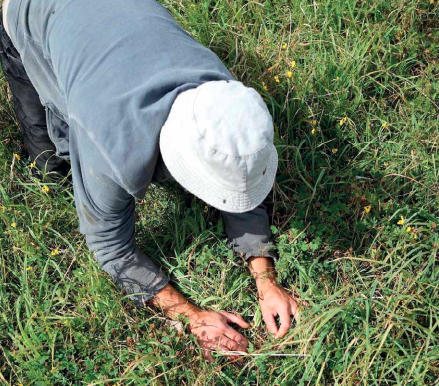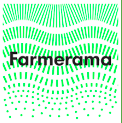By Olivia Oldham, Farmerama
Do you learn the most talking to other farmers? Don’t always find the time to get out there and hear what’s going on? Well that’s what we are here for.
I am part of Farmerama Radio, an award-winning podcast released once a month sharing the voices of farmers in the UK and around the world. Farmerama is committed to positive ecological futures for the earth and its people, and we believe that the farmers of the world will determine this. Each month we feature recordings of farmers in the UK and further afield, focused on practical tips, innovative ideas and the nitty-gritty of farming today.
We are sharing knowledge of what really works in the field and for farming businesses, from farmer to farmer. Every episode includes three to four different short stories that we weave together. Here we will give you a taster of four stories from four different episodes to whet your appetite. We definitely encourage you to give the episodes a listen because there is lots more to learn than what we cover here, plus it’s always better to hear it from the farmer’s mouth!
You can find the show online at www. soundcloud.com/farmerama-radio/ or farmerama.co, or if you already listen to podcasts then it’s accessible on any podcasting service, just search for Farmerama. Here we go…

Episode 36: Cowpat Lover Greg Judy at Groundswell Conference
In episode 36, we spoke with Greg Judy, a mob grazer based in Missouri, about how mob grazing provides a triplewin by improving soil health, grassland biodiversity, and farm profitability, all with the goal of increasing the longterm viability of a farm. And all this can be achieved even with limited resources. Mob grazing involves putting larger numbers of animals onto smaller areas of land, and moving them around daily, as opposed to giving them access to the whole field continuously.
The mob grazing approach affects the biology, chemistry and physics of the soil. Biologically, it allows different grasses, the seeds of which are already in the soil, to germinate and come up. Mob grazing is also far more effective than continuous grazing at spreading manure across a piece of land. For example, Greg told us that on a farm of 100 acres, it would take 27 years under a continuous grazing management strategy to cover the whole farm with cowpats. With mob grazing, though, the same coverage could be achieved in only one and a half years. This manure coverage improves the chemical and physical composition of the soil by providing extremely good fertilization and creating a better environment for worms.
None of this matters, though, if the farm enterprise isn’t sustainable. Using the cattle’s (or other livestock’s) own natural waste reduces the need for fertiliser inputs, while using livestock to increase the variety of grasses in the pasture reduces the need to buy grass seed, for example. By moving the animals every day and keeping them away from their manure and urine, they are also kept away from the flies which are attracted to fresh waste. This is a simple and free way of keeping animals healthy and reducing the incidence of problems like worms. So, Greg says, “one of the best investments to make to improve farm profitability is in water infrastructure and fencing to be able to implement mob grazing”.
Speaking of sustainability, Greg emphasised that more than being sustainable, we should be aiming to be regenerative. If we come onto land that has been degraded by unsustainable practices in the past, we don’t want to ‘sustain’ it at its existing levels – we want to regenerate it and make it better for future generations. Mob grazing is one way to do this, using animals to restore soil health. An extended interview with Greg can also be found in this month’s short.
Episode 35: California Paying Farmers to Sequester Carbon with Charles Schembre
In episode 35, we learned about California’s Healthy Soils Program, a scheme which compensates farmers for increasing their soil health – with the goal of sequestering carbon and increasing water retention. For example, one farm is being paid USD50,000 to sequester 345.6 tonnes of greenhouse gases per year. They plan to do this by transitioning to a minimum-tillage approach, planting multi-species legume cover crops, and spreading compost across 70 acres. The quantities sequestered under the scheme are estimated using CARB GHG [carb G-H-G] Quantification Methodology and tools.
This Healthy Soils Initiative is particularly relevant in the UK at the moment as the government considers how farming subsidies will operate after Brexit. We hear an on the ground account of the Healthy Soils Initiative from Charles Schembre, a long-time grower, farm manager and soil conservationist and now a Vineyard Conservation Coordinator at Napa County Resource Conservation District. Charles told us that the Healthy Soils Program is the first time in the United States that it has been recognised at a state-level that soil regeneration is an effective weapon in the climate-change-mitigation arsenal.
Charles pointed out that it can be tempting to look at soil regeneration through a narrow ‘carbonsequestration, climate-change’ lens, but it is important to take a broader view. Regenerative soil management can improve the entire ecological function of the land, including water retention, the reduction of erosion, yield enhancement, and habitat creation. Taking a more holistic view also involves stepping back from the traditional farming lens many of us have had since at least the end of the second world war and begin to question why we do the things we do, why we think things should look a certain way or with a certain technique or approach.
For example, Charles said that as a Californian farmer, he might see a field with long grass and, having been conditioned to think in a certain way, add mowing the field to his list of jobs. But if he stops to think critically and holistically about that task, he might remember that, biologically, chlorophyll is necessary to pull carbon out of the atmosphere and into the soil. In a dry place like California, mowing pretty much kills the plants and eliminates much of that sequestering potential. Additionally, when grass gets quite tall, it captures dew much better and allows the top-soil to stay more moist (anecdotally at least). “If you want to capture carbon,” said Charles, “you’ve got to think like carbon.”
You can hear more about the carbon farm plans Charles has worked on (together with the Carbon Cycle Institute) for 4 vineyards in Napa county, and details of how they monitor soil health and carbon sequestration, in this month’s short.
Episode 28: Using Fungal Innoculants to Foster Perennial Grasses with Joel Williams
Finally, in episode 28, we spoke with Joel Williams of Integrated Soils about using nothing more than the microbial balance of the soil to manage weeds. Although his example related to golf courses rather than pasture, the same principles apply! On golf courses, groundskeepers cultivate certain species of perennial grasses which are best for creating a smooth, fine playing surface. Other types of grasses, like an annual called meadow grass, are difficult to manage, because herbicides cannot be used to manage them. Both are grasses, and so a herbicide would affect not only the unwanted ‘weed’ grass, but also the desirable perennial.
Joel explained that you can apply fungal ‘innoculants’ to do the job instead. Essentially, this means applying beneficial fungi, and food to feed the fungi, to the soil. The soil becomes more fungal-dominated, which is an environment more favourable to the perennials the groundskeepers want, and less favourable to the annual they want to get rid of. The perennials grow with more vigour, while the annual becomes stressed, and within a season or two, the perennial is able to outcompete the annual.
Joel emphasised that it is important to remember that soils are very complex ecosystems, despite our tendency for simplification. Although simplicity is important to make things easier to understand, taking too narrow a view can be detrimental. When trying to improve soil health and anything that flows from that, such as crop yield, we have to take a step back and not box ourselves into one or two parameters in our attempt to make assessments on the health of the system. Soil chemistry is relevant, of course, but so too is soil physics and its structural properties, such as aeration, and soil biology. It is crucial, also, to remember that living plants are another part of the soil picture – they contribute to soil health, for instance, by drawing down carbon from the atmosphere. According to Joel, “soil and plants are one.” If you have a story you want to feature on the show or know someone who we should feature, then please get in touch via our website farmerama. co. You can also find us on facebook, twitter @farmerama__ and instagram @ farmerama_radio. We look forward to hearing from you!

